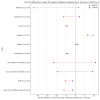With these 4 included, I found a cohen_d of 0.008 and p_value of 0.93. With them excluded, things change quite dramatically. The effect sizes goes to d =0.44 and the p-value = 0.000151.
That looks like a reasonable difference. Also tried scipy.stats.mannwhitneyu on the full sample and got a p-value of 0.00503.
I'm getting the same cohen d value for with and without the outliers, but different t-test and mann-whitney values.
I highlighted the results for workload absolute difference at AT because it matches the t-test and cohen d values from your first calculations.
With outliers included:

Outliers removed:

That's with Jamovi. Same results with Python on the full dataset:
Code:
mecfs_df = df[df['phenotype'] == 'MECFS']
hc_df = df[df['phenotype'] == 'HC']
es = cohend(mecfs_df['AT_wkld_diff_percentage'], hc_df['AT_wkld_diff_percentage'])
U1, mw_p_val = mannwhitneyu(mecfs_df['AT_wkld_diff_percentage'], hc_df['AT_wkld_diff_percentage'])
t_stat, tt_p_val = ttest_ind(mecfs_df['AT_wkld_diff_percentage'], hc_df['AT_wkld_diff_percentage'], equal_var=False)# MECFS: 84
# HC: 71
Cohen's D: -0.00812
Mann-Whitney p-value: 0.04783
Welch's t-test: 0.95745
With PI-026 removed (but outliers included), the Mann-Whitney p-value goes from 0.048 to 0.044: (note the second metric is different from above)

Last edited:
















